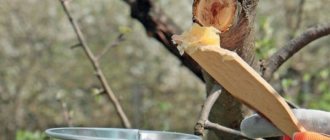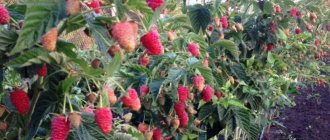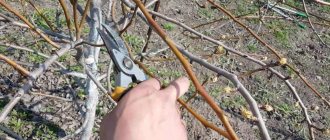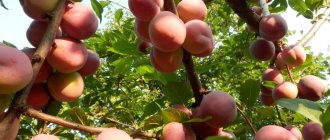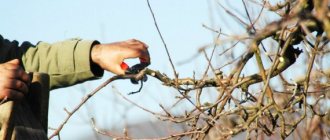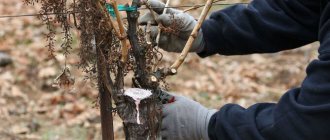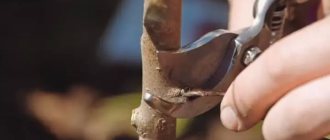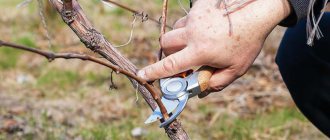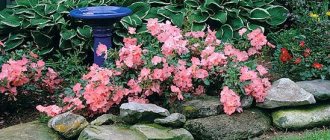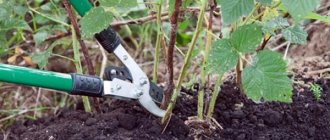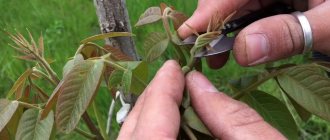Peach is an extremely demanding crop to care for. The main component of growing this fruit tree is annual, correct pruning. In order not to harm the plant and not reduce the abundance of fruiting next year, it is important to know the basic rules and principles of this important event.
Usually, the branches of a tree bear many more fruits than it can provide with nutrients, and therefore the fruits become smaller, lose their richness of taste, and may simply fall off without ripening. Such overload leads to the death of the plant over several years.
Why is autumn pruning necessary?
This is a mandatory agrotechnical event. Pruning is carried out in spring, summer or autumn. Moreover, all stages are important. In the spring, the crown is formed, damaged branches are removed in the summer, and the tree is prepared for winter in the fall.
To properly trim a peach in the fall, the following tasks should be solved simultaneously:
- Shortening branches.
- Elimination of broken shoots.
- Identifying and pruning diseased branches.
Experienced gardeners say that no more than 8 dozen branches should remain on the tree. This amount will allow the growth energy to be properly distributed in the spring. The nutrition received from the ground will go, first of all, to fruit-bearing branches and fruit ovaries.
Types of peach tree pruning
- Economic – removal of diseased, non-viable and weak branches, the goal is to preserve the health of the peach;
- Rejuvenating – branches that do not bear fruit are removed, the goal is to increase fertility;
- Contour – removal of branches that spoil the aesthetic impression, the goal is to form a crown of a given type;
- Differentiated - cutting off the top of a young plant, the goal is to limit growth in height, stimulate branching;
- Detailed - removal or shortening of most branches, the goal is complete renewal of the plant;
- Restorative – removal of damaged branches and severe pruning of healthy branches, the goal is to stimulate growth and preserve the harvest. Used after severe frosts.
Deadlines
In the fall, the tree’s growing season is already over, it is preparing to “fall asleep” and survive the cold. In this state, any injuries are more easily tolerated. That is why the shortening of fruiting branches and the reduction in their number is usually postponed until autumn.
Choice of trimming dates:
- fruiting is over, the entire harvest has been harvested;
- the tree's growing season is over;
- The suitable period is early September to mid-October.
Choosing a fall pruning date for your peach tree
When figuring out when it is best to prune a plant, you should take into account the goals of the procedure. Trimming is stressful for any tree, so you need to take into account all the details of the manipulation in advance.
When deciding whether a peach can be pruned in the fall, take into account the region of residence. The procedure is carried out in summer, spring and autumn. Each manipulation has its own importance. Autumn haircuts are safer than those done at any other time. The planting begins to prepare for wintering and easily tolerates the procedure.
Note!
The best time for a haircut is from early September to mid-October. This period is relevant for the southern regions. In other areas, it is better to trim in September.
The main thing is that pruning of young peach in the fall should be carried out before the cold snap. Haircutting is strictly prohibited when the temperature reaches zero at night. This must be taken into account when deciding when it is better to prune a peach in the fall and in what month.
Tools and their preparation
Even the most correct pruning causes serious damage to the tree if unprepared tools were used. It is necessary to take care of the selection and condition of equipment.
How to prepare the instrument:
- sharpen;
- disinfect;
- remove rust;
- remove burrs.
All instruments must be in full working order. This will protect your hands from injury and the branches from unnecessary damage.
How to disinfect instruments:
- Soak the equipment in a dark purple solution of potassium permanganate. Or use a 3% solution of Bordeaux mixture. To obtain such a solution, dilute 30 ml of the drug in a bucket of water. The cutting parts must be completely immersed in the disinfectant solution.
- After half an hour, remove the disinfected instrument.
- Place the tools on a clean surface and wait until they dry. Drying occurs naturally.
- Wipe the dried surfaces with a swab soaked in medical alcohol.
- When the alcohol film has dried, the tools are ready for use.
Tool requirements:
- Secateurs. It should have tightly closed cutting surfaces. To check the tightness of the closure, cut a piece of paper with pruners. It is better to use pruning shears with long blades. Then it will be easier to get deep into the crown. Use pruning shears to cut branches up to 2.5 cm thick; it cannot handle thicker ones.
- Lopper. The same requirements apply to it as to pruners. The lopper differs from the latter by longer handles, which serve as a kind of lever. The handles allow you to trim branches up to 5 cm in diameter without any extra effort. Thicker branches should not be trimmed with a lopper. It will cope with the task, but the cuts will be uneven, with frayed edges. because of them, wounds will take too long to heal.
- Garden saw. The thickest branches are cut with it. The interval between the tips of the teeth should be 2 times greater than the thickness of the blade. A saw with this feature will not jam, since the cuts will not become clogged with sawdust.
- Garden knife. It should fit comfortably in your hand. Manufacturing material – high quality steel. The optimal blade thickness is 1.5 mm. Typically, garden knives are used for grafting. It can also be used to correct various errors.
- Scissors. They are needed for cutting several thin branches at the same time. Thick crowns are usually trimmed with scissors. It is best to use lightweight models with rounded ends. Gardeners prefer to work with all-metal scissors without plastic handles.
On a note!
Garden centers sell amateur and professional pruners. The latter are more convenient and durable, but cost twice as much.
What happens if you don't prune?
The pruning process is labor-intensive, so many may wonder whether it is possible to do without this manipulation. Unfortunately this is not possible. Without pruning, it will not be possible to grow a healthy, strong, normally fruiting tree.
The peach is capable of intensively forming shoots, and if they are not rationed, the plant will constantly be overloaded with the harvest, taking away all its strength. Gradual depletion leads the tree to weakened immunity and, as a result, to disease and early death.
Peach pruning technology
The technology for autumn pruning of peach trees depends on many nuances. They take into account the age of the tree, its condition, crown shape, climate, etc. Up to 5 years, a peach tree is considered young, and after 5 – old.
Types of pruning
Pruning allows you to solve several problems at once. To decide which branches to trim, you need to decide on your goals. Some trees need rejuvenation, others need to get rid of excess shoots.
There are two main functions of trimming:
- Thinning. The branch is completely removed - old, diseased, dry. Thinning procedures have virtually no effect on yield. Their task is to rejuvenate the peach and give it new strength.
- Shortening. It can be weak, moderate or strong. In the first case, a quarter of the length is removed from 5% of the branches. In the second, a third of the length is removed from 10%; in the third, half the length is removed from 20%.
Depending on the goals pursued and the technique of implementation, the following types of pruning are distinguished:
- Rejuvenating. Conducted from the age of two. Up to 20% of shoots are pruned. If you remove more, the tree may die.
- Sanitary. Remove all affected branches. Frozen, damaged by insects and diseases, dried out, broken.
- Formative. It consists of creating a crown of a certain shape by trimming certain branches.
- Restorative. Used when the crown is frozen or damaged by various natural disasters. This is a radical option that involves removing all damaged parts of the tree.
- Differentiated. Thinning the top of the crown in order to stimulate development. Used on peaches for 5-10 years.
Young and old peaches
The main principle of pruning is caution. You cannot prune branches indiscriminately. It is necessary to shape the crown and remember that excessive zeal can destroy the peach.
How to trim a young peach:
- the central shoot can be pinched if there are young branches on it;
- when planting seedlings, leave up to 4 branches;
- In the 3rd year of life, the central branches are cut as short as possible.
Rejuvenation of trees after 8 and 10 years
Trees need annual anti-aging pruning after reaching 8 years of age if the peach was grafted, and 10 years of age if the plant was grown independently. At the very beginning of the procedure, all dried, damaged and infected shoots are removed, then the old branches are shortened to 3-4-year-old wood, cutting off parts of the tree that are no longer capable of high-quality fruiting.
If the peach has reached the age of 12 years without undergoing anti-aging pruning, then measures should be taken immediately to restore it, otherwise the tree may die. In this case, only 2-3 of the strongest branches are left on the crown of the plant, which are shortened by 1/3 of the length, the rest is cut into a ring.
If the parts of the tree intended for cutting exceed a third of the entire crown in volume, then pruning must be carried out in stages. By removing half of the fragments at once, the gardener risks causing serious wounds to the crop, which due to its age is not able to recover.
After the pruning is completed, shoots growing from the root or above the grafting site begin to form a strong skeletal branch, which in 2–3 years should grow stronger and completely replace the old trunk.
Possible mistakes
Errors when cutting are unacceptable. That is why many novice gardeners do not dare to do it themselves. Some, afraid of cutting off anything unnecessary, allow the crown to thicken. Others, more determined, remove more than necessary. As a result, they are left without a harvest. Or no tree at all.
When pruning fruit trees you must:
- Read pruning instructions carefully;
- watch a training video;
- train on old/sick trees.
Errors often made by gardeners:
- Excessive shortening of branches leads to delayed formation of flowers, and subsequently fruits.
- Neglecting pruning leads to a deterioration in the taste and aroma of the fruits and their shrinkage. Trees that are not regularly pruned bear fruit irregularly, become thickened, quickly age and “go into circulation.”
- Many gardeners do not measure and form the angle of inclination of the branches to the trunk. If this is not done at the age of two, you will not get a beautiful crown.
- Failure to comply with pruning deadlines leads to various problems. So, if you are late with pruning, the branches may freeze during the first frost. Work must be completed before frost sets in. A freshly cut area runs the risk of frostbite or rotting. Do not prune at temperatures below +5°C. In cold weather, wood becomes brittle, cuts are uneven, and the tree is severely injured.
Carrying out
The quality of the fruit depends on the correctness of the circumcision procedure.
Types of shoots
Types of shoots are presented in the table.
| View | Purpose |
| Tops | A good basis for crown formation. Serve as a replacement for skeletal branches in case of freezing. |
| Bouquet | They are distinguished by their small length (up to 35 cm). They form small fruits that do not have time to ripen. |
| Growth | They must be removed so that the tree does not waste its energy on them. |
| Summer | They do not produce crops and do not survive winter conditions. |
| Fruit | The length is 20-25 cm, the ovaries on them do not bear fruit. |
| Mixed | It cannot be pruned; fruit and vegetative buds grow on these shoots. |
Rules
Peach pruning in the fall is carried out according to the scheme given below and includes the following rules:
- Carrying out the first procedure only six months after planting the peach.
- Trimming the top of the tree to a height of 1 meter. It is necessary that the trunk have two supporting branches or buds. These elements are tied to supports. The angle between the supporting branches and the bud should be 45 degrees.
- Cutting off the remaining side shoots of the upper bud.
- In the second year, the central shoot is cut off at the bifurcation of the lateral skeletal branches.
- After another year, the supporting branches are cut off by 1/3, in addition, the growth buds are cut off.
Following the instructions will result in the first harvest appearing on the tree in the fourth year.
Formation of a cup-shaped crown
Distinctive features of the crown:
- absence of a central conductor;
- the presence of one tier of 3-4 main branches.
The fruit of this crown shape has a beautiful color and good taste.
Spindle-shaped
Allows you to save space. Advantages:
- uniform illumination of the crown from all sides;
- easy care;
- high quality harvest.
A significant drawback is reduced frost resistance.
Bush-like
It is formed by leaving four young shoots formed from low-lying buds. These branches will begin to bear fruit in 2 years. Subsequently, the peach is cut off at the level of the root collar and a bush is formed from summer branches.
Reviews
Vitalina, 57 years old
For a long time I couldn’t figure out how to trim a peach. I watched the video and realized that I just regret cutting off the shoots. The hand does not rise to cut branches on which fruits may grow. When I realized that with my pity I would hurt the tree and deprive myself of the harvest, the problems became much less. Every autumn I remove not only dry and diseased shoots, but also extra branches that thicken the crown.
Arkady, 49 years old
When growing a peach, it is important to understand that the more you prune it, the more it grows. There is no way to do without removing the branches, because there are no fruits on two-year-old branches. That winter, all the fruit buds on my peach froze. I had to cut everything off. Only the skeletal branches and the thickest ones remained. As a result, I lost 2/3 of the tree. But the very next summer it grew so much that almost the entire crown was restored.
Peach is one of the most capricious fruit crops. He painfully endures all procedures related to the removal of branches. But you cannot refuse autumn pruning; the quality and quantity of fruits, as well as the durability and health of the entire tree, depend on it.
Depending on the age of the peach
It is important to understand that the formation of the crown occurs in several stages. Circumcision should not be carried out earlier than six months after planting.
Young seedling
Requires formative pruning. The procedure will allow you to get a beautiful crop that consistently produces crops.
Over 3 years old
The period is characterized by the formation of lower branches of the second order. To do this, the length of shoots on skeletal branches is shortened to 40 cm.
After 8-10 years
Every spring it is necessary to remove damaged branches and young growth at the base of the crop.
Is it possible to prune a peach in summer?
Trees obtain nutrients from the soil . They pass through the trunk and are evenly distributed between the branches. In peach, these processes occur much faster than in other crops.
The tree immediately spends the incoming nutrients to form growing branches. Without regulatory pruning, the crown will quickly thicken, and the central branches will become bare and stop producing fruit. Fruit will begin to set on peripheral branches, causing the plant's productivity to decrease.
Regular pruning of improperly growing branches will help prevent the problem. A properly formed crown improves ventilation, facilitates harvesting, and gives the tree aesthetics.
When to prune
Peach pruning is carried out in mid-spring in the middle latitudes of Russia. In the southern lanes a little earlier - from the end of March. The air temperature should not fall below +5°C at night.
Pruning a tree with open buds at a temperature of -2°C at night can have a detrimental effect on fruiting: the tree will bloom prematurely and subsequently will not survive the winter well. If pruned later, the tree may not bear fruit.
Formation of a young tree and maintenance of crown configuration
Most gardeners consider the optimal crown shape for peach to be a “bowl” or “improved bowl”. The difference between them is that in the first case, the skeletal branches extend from almost one point on the trunk, and in the second, there is an indentation of about 15–20 cm in height between them. The main advantage of this configuration is good aeration and uniform illumination of the crown. This contributes to faster ripening of fruits, improving their taste and quality. At the same time, aeration is an effective prevention of pest attacks and the development of diseases.
Further care of the plant
After pruning, the crop needs careful care. Experienced gardeners recommend using oil paint instead of garden varnish to lubricate the cuts, since wounds from it sometimes begin to rot due to excess moisture. The paint has better sealing properties and prevents rotting more effectively. RanNet paste has similar properties.
Before applying the putty, the wounds are dried with a 3% solution of copper sulfate, which is applied with a sponge and left for 1-2 hours. Then putty is applied to the cut.
The set of mandatory procedures includes:
- weeding;
- loosening the soil in the tree trunk circle;
- mulching with organic matter (chopped bark, rotted sawdust, mown grass, mature compost).
It is not recommended to use hay as mulch as it becomes a haven for rodents.
Important! Mulching the tree trunk relieves the gardener from routine work - loosening and weeding. Organic matter retains moisture inside the soil and reduces the frequency of watering, providing the peach with nitrogen and carbon dioxide.
In the summer, trees are fertilized with potassium and phosphorus, and nitrogen is forgotten until next spring. For foliar feeding, use the complex product “Zdraven AQUA for fruit trees”. At the end of August, Plantafol is sprayed to stimulate the ripening of wood.
If there is a shortage of natural precipitation, trees are shed to a depth of 0.5 m. Moistening is stopped 2 weeks before harvest. In autumn, moisture-recharging irrigation is carried out to prevent freezing of the root system in winter. The logs are whitened with Sadovnik lime paste.
In regions with little snow, additional dry shelter is created from reed or corn huts and agrospan hoods.
The first stage of work on covering the peach for the winter begins after the leaves fall, before the onset of frost, so that the branches are easier to lay on the ground. To save covering material, the tree is bent as low as possible. Small shoots are connected and tied to the main branch. The procedure is carried out carefully so as not to break the plant. Old branches can be cut off as they are difficult to bend.
To protect trees from rodents, a repellent is placed in the center of the bush. Additionally, trees are treated with the following compounds:
- a mixture of clay and cow manure with carbolic acid (1 tbsp per 10 liters of mixture);
- a mixture of fish oil and naphthalene in a ratio of 8:1.
The mechanical method of protection involves tying the trunk with special nets, roofing felt, and spruce branches. Dense materials are removed during the thaw period to prevent the formation of condensation.
This is interesting:
Methods for propagating peach by cuttings in summer: instructions and useful tips
Pruning seedlings during planting
For good development of peach, it is necessary to carry out age-appropriate pruning from the first years of life.
Heavy pruning is contraindicated for young plants. It is enough to identify the skeletal branches and remove the unnecessary, competitive ones. This must be done with great care. It is best to carry out such pruning in early spring, after the air has warmed to above-zero temperatures.
The essence of the first pruning is the choice of skeletal branches
The formation of a crown with three skeletal branches is carried out as follows:
- First of all, determine the height of the trunk (50-60 cm). If desired, you can begin the formation of the crown at a smaller distance from the ground. This has its advantages: the tree is easier to process, easier to harvest, and the plant does not require anti-aging pruning longer. However, with a low bole, tillage under the tree becomes more difficult, and the lower branches bend to the ground under the weight of the fruit, which contributes to the peaches becoming soaked during rain and their subsequent rotting.
- At the desired height of the trunk, the first skeletal branch is selected among the powerful shoots. It should deviate quite strongly from the trunk (at least 45 degrees).
- The second skeletal branch is selected from the opposite side, 3-5 buds higher than the first.
- If, when viewed from above, it is noticeable that the two selected branches are located not opposite, but at an angle to each other, then the third branch, together with the two previous ones, should divide the conditional circle around the trunk into three equal segments.
- Above the third branch, the conductor (central shoot) and all other branches are removed.
If the direction of the lower branches is mutually opposite, 4 skeletal branches are chosen to lay the foundation of the future crown.
- The two upper branches should be perpendicular to the lower ones.
- It is advisable to leave the third branch 5-6 buds from the second, and the fourth - a little higher.
- The conductor is cut off above the fourth branch. All other shoots are also removed.
If the skeletal branches on a seedling are selected from young shoots, then excess branches should be cut out only after their lower part has become lignified. Violation of this rule can lead to a decrease in the angle of departure of the abandoned branches.
Care after pruning
After pruning a tree, it needs proper care. This will help the plant recover faster after the procedure. Will allow him not to be exposed to diseases or pest attacks.
Here are the basic rules:
- Burn everything that is cut from plants to prevent the possibility of spreading diseases or fungal infections;
- treat the sections that were formed after pruning, that is, wounds, with garden varnish;
- treat minor damage to the integrity of the bark obtained during cutting with potassium permanganate or boric acid;
- treat the entire tree with a special solution;
- After pruning is done, water the tree generously;
- in the spring, lay mulch around the tree trunk (you will learn how to mulch the soil in this article).

